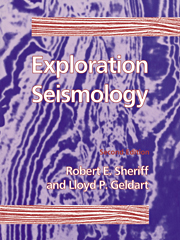Book contents
- Frontmatter
- Contents
- Preface
- Mathematical conventions and symbols
- 1 Introduction
- 2 Theory of seismic waves
- 3 Partitioning at an interface
- 4 Geometry of seismic waves
- 5 Seismic velocity
- 6 Characteristics of seismic events
- 7 Equipment
- 8 Reflection field methods
- 9 Data Processing
- 10 Geologic interpretation of reflection data
- 11 Refraction methods
- 12 3-D Methods
- 13 Specialized techniques
- 14 Specialized applications
- 15 Background mathematics
- Appendices
- Index
13 - Specialized techniques
Published online by Cambridge University Press: 05 June 2012
- Frontmatter
- Contents
- Preface
- Mathematical conventions and symbols
- 1 Introduction
- 2 Theory of seismic waves
- 3 Partitioning at an interface
- 4 Geometry of seismic waves
- 5 Seismic velocity
- 6 Characteristics of seismic events
- 7 Equipment
- 8 Reflection field methods
- 9 Data Processing
- 10 Geologic interpretation of reflection data
- 11 Refraction methods
- 12 3-D Methods
- 13 Specialized techniques
- 14 Specialized applications
- 15 Background mathematics
- Appendices
- Index
Summary
Overview
Lesser-used techniques are discussed in this chapter. Seismologists should be familiar with them because they provide the most efficient means of gaining needed information under special circumstances.
S-waves depend on different elastic properties than P-waves and hence yield additional information when combined with P-wave studies (§13.1). Especially in anisotropic situations, as is likely where fracturing is present, they may yield more definitive information than obtainable from P-waves. Additional information can also be obtained by treating wave motion as a vector with three-component recording (§13.2) rather than dealing with only the component of motion in one direction.
Seismic waves trapped in low-velocity channels (§13.3) can be used to obtain information about the properties of the channels. However, their analysis is difficult because they are highly dispersive.
Vertical seismic profiling (VSP) (§13.4) provides one of the best means of relating reflection events to the specific interfaces involved in their generation. VSP also provides the means to see, with higher resolution than available with surface data, what may lie ahead of the drill bit or what changes may lie to the side of a borehole.
Tomographic methods (§13.5) provide a different kind of approach to inverting traveltime (and, in theory at least, amplitude) measurements to determine distributions of velocity (and absorptive properties). Although their use is relatively new and the best means of application are still being developed, they are especially applicable to resolving borehole-toborehole measurements.
- Type
- Chapter
- Information
- Exploration Seismology , pp. 471 - 504Publisher: Cambridge University PressPrint publication year: 1995



